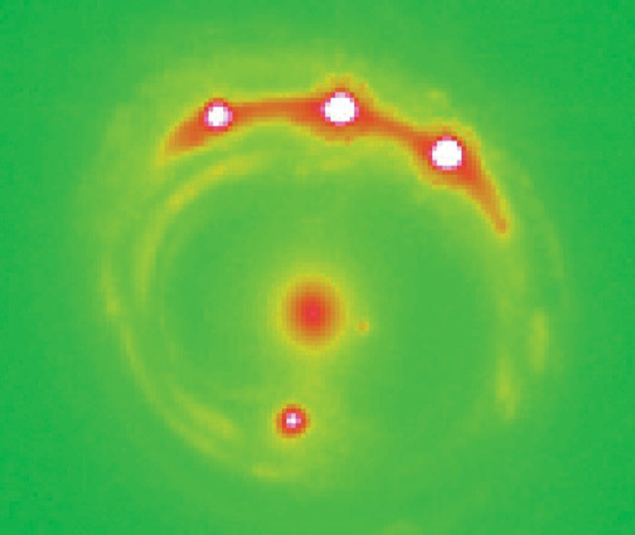
Three decades since astronomers first detected planets outside our solar system, exoplanets are now being discovered at a rate of hundreds per year. Although it is reasonable to assume other galaxies than our own contain planets, no direct detections of such objects have been made owing to their small size and their large distances from Earth.
Now, however, radiation emitted around a distant black hole has revealed the existence of extragalactic planets in a galaxy 3.8 billion light years away, located between the black hole and us. The planets, which have no way of being directly detected using any kind of existing telescope, are visible thanks to the small gravitational distortions they inflict on X-rays emanating from the more distant black hole.
The discovery was made by Xinyu Dai and Eduardo Guerras from the University of Oklahoma in the US using data from the Chandra X-ray Observatory. The distant black hole in question, which forms the supermassive centre of the quasar RX J1131-1231, is surrounded by an accretion disk that heats up as it orbits and emits radiation at X-ray wavelengths. Thanks to a fortunate cosmic alignment, this radiation is amplified by gravitational lensing and therefore can be studied accurately. The lensing galaxy positioned between Earth and the quasar causes light from RX J1131-1231 to bend around it, appearing to us not as a normal point-source but as a ring with four bright spots (see figure). The spots are a result of radiation coming from the same location of the quasar, which initially followed different paths but ended up being directed to the Earth.
Dai and Guerras focused on the spectral features of iron, a strong emission line that reveals details of the accretion disk, and found that this emission line is not just shifted in energy but that the amount of the shift varies with time. Although a shift in the frequency of this line is common, for example due to relative velocities between observers, its position is generally very stable with time when studying a specific object. Based on the 38 times RX J1131-1231 had been observed by the Chandra satellite during the past decade, the Oklahoma duo found that the energy varied significantly between observations in all of the four bright points of the ring.
These observations thus form the best evidence for the existence of extragalactic planets.
This feature can be explained using microlensing. The intermediate lensing galaxy is not a uniform mass but rather consists of small point masses, mainly stars and planets. As the relatively small objects within the lensing galaxy move, the light from the quasar passing through it is deflected in slightly different ways, causing different parts of the accretion disk to be amplified at different levels over time. As the different parts of the disk appear to emit at different energies, the measured variations in the energy of this emission line can be explained by the movement of objects within the lensing galaxy. The question is: what objects could cause such changes over time scales of several years?
Stars, being so numerous and massive, are one good candidate explanation. But Dai and Guerras calculated that the chance for a star to cause such short-term variations is very small. A better candidate, suggest fits to analytical models, is unbound planets which do not orbit a star. The Chandra data were best described by a model in which, for each star, there are more than 2000 unbound planets with masses between that of the Moon and Jupiter. Although the exact population of such planets is not well known even for our own galaxy, their number is well within the existing constraints. These observations thus form the best evidence for the existence of extragalactic planets and, by also providing the number of such planets in that galaxy, teach us something about the number of unbound planets we can expect in our own galaxy.
Further reading
X Dai and E Guerras 2018 ApJL 853 L27.





